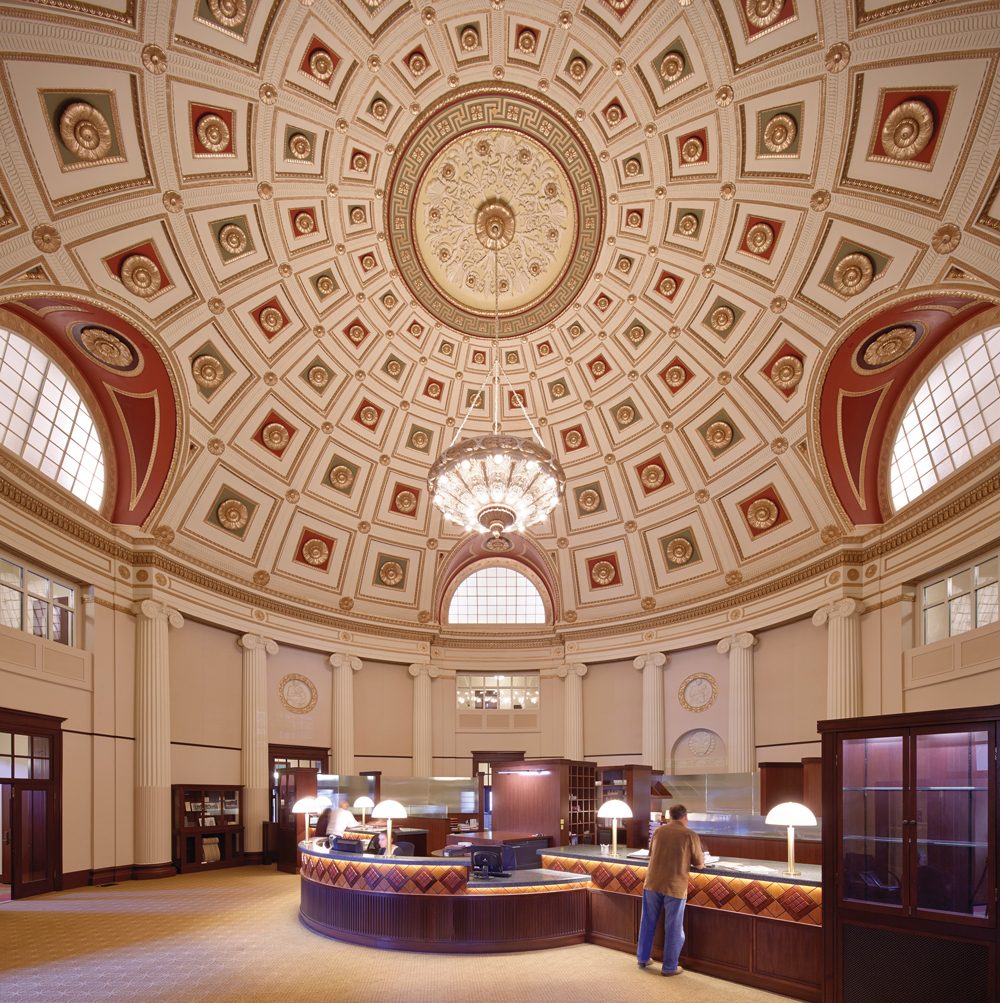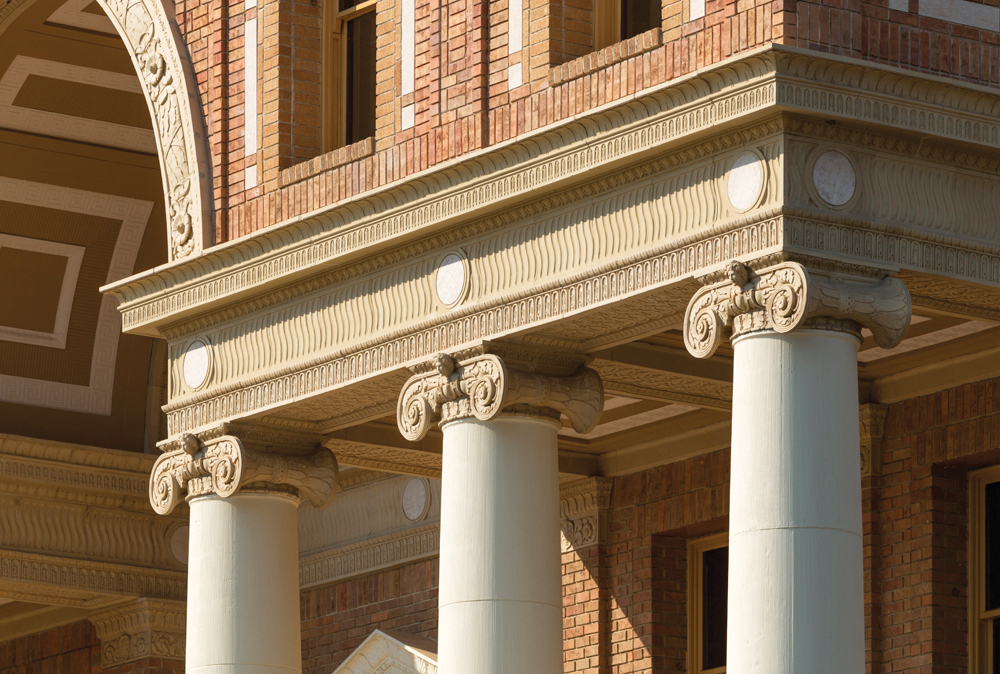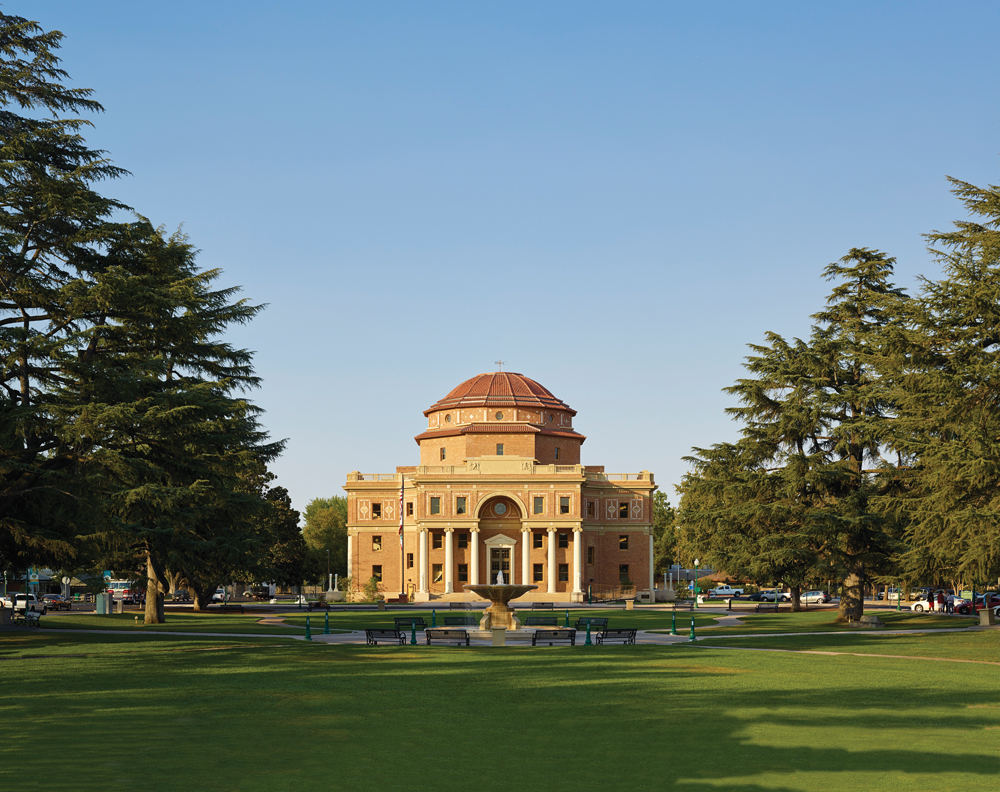Upon its completion in 1918, the building that is now the Atascadero (Calif.) City Hall was the very picture of stability. Intended as the centerpiece of Atascadero Colony—a planned utopian community—the Italian Renaissance structure featured a cruciform plan, with ornate central rotundas on the first and fourth floors.
Though the idealized colony never really jelled, the area did thrive, and the building passed through several commercial uses before the County of San Luis Obispo acquired it in 1950. When the city of Atascadero was incorporated 29 years later, the county handed the building over for city offices. The hall, with its grand pillared entrances and red-tiled dome, is featured on the city seal and listed on both the National and California Registers of Historic Places.
In December 2003, the 6.5 magnitude San Simeon earthquake ravaged Atascadero. As city workers dove for cover, the upper rotunda was twisted and wrenched away from its structural moorings. Interior walls and exterior masonry were extensively damaged, and the building was ultimately red-tagged. However, city officials were determined to restore, and improve, the beloved landmark.
Pfeiffer Partners Architects undertook a two-year assessment, including a laser-scan analysis as well as painstaking physical investigations and measurements. The Atascadero Historical Society, an enthusiastic collaborator, provided invaluable documentation of original conditions. Three packages of work were eventually developed: demolition, FEMA-funded damage repair and hazard mitigation, and city-funded rehabilitation.
PLATINUM AWARD
ATASCADERO CITY HALL
Atascadero, Calif.Building Team
Submitting firm: Bernards (construction manager)
Owner: City of Atascadero
Architect: Pfeiffer Partners Architects
Structural engineer: Nabih Youssef Associates
MEP engineer: Davidovich & Associates
General contractor: Diani Building Corp.General Information
Size: 58,900 sf
Construction cost: $21.7 million
Construction time: June 2010 to September 2013
Delivery method: CM agency/multi-prime
The 2008 economic crash posed financial difficulties, and anticipated state funding was eliminated in the subsequent recession. Meanwhile, water infiltration caused additional damage despite the owner’s best efforts to keep rain out. Under the management of Bernards, construction finally began in 2010, nearly seven years after the quake occurred.
Stabilizing the structure was obviously the most pressing need. The original building consisted of cast-in-place reinforced concrete floors and unreinforced masonry infill walls between a structural steel, concrete-encased post-and-beam skeleton. Above the fourth floor, the building was essentially an unreinforced masonry structure.
Crews strengthened the existing foundation by drilling 248 micro-piles 80 feet deep into bedrock, and pouring pile caps below the foundation. A new structural concrete slab-on-grade was installed at the basement level. Interior perimeter walls up to the fourth floor were stripped to reveal the structure, which was reinforced with more than a million tons of shotcrete and 80,000 pounds of rebar—in essence, creating a building within a building.
To fix the upper floors and dome, crews removed most of the exterior cladding, then rebuilt with additional steel and fiber-reinforced polymer instead of shotcrete, which would have been too heavy. Existing steel was horizontally and vertically braced, and roof dome framing members were retrofitted.
When structural improvements were complete, crews used as much of the original masonry as possible to rebuild the walls and roof. In the heavily damaged upper section, about 15% of the roof tiles and 80% of the bricks had to be replaced with color-matched materials. When possible, original tiles, fascia balustrades, and decorative plaster were repaired, cleaned, and returned to their original spots.

The lower rotunda benefited from a new paint scheme inspired by the greens and browns of the California landscape; the painter, a local artisan, donated half of his change-order hours back to the city. Second-floor window overlooks, once blocked, were uncovered and restored, providing views into the space from surrounding office zones. Light boxes behind frosted lunettes give the illusion of natural daylight. In reality, this dome is internal and is topped by a second rotunda housing the City Council chambers.
IMPROVING INTERIOR DESIGN
Interior reconfiguration was also crucial to improving functionality. Over the years, alterations had resulted in a confusing layout and awkwardly shaped spaces, as well as problematic ventilation. Crews removed most of the interior partitions and built new walls to establish a more sensible floor plan. Efficient HVAC and communications infrastructure was installed.
The lower rotunda was programmed as lobby space and a permit center. Three floors of offices surround this focal point. City Council chambers were constructed in the domed upper rotunda, which once held a library. A small historical museum received a place of honor, reinforcing the building’s link with the town.
More than 90% of construction dollars went to firms on the Central Coast, including $5.5 million to local glass, concrete, and masonry contractors. The final construction cost was $3.3 million less than the original $25 million estimate. Bernards credits the multi-prime contract process, encompassing 17 separately bid categories, for the savings. City Hall opened on schedule in August 2013, just in time for Atascadero’s centennial—an embodiment of civic resilience, determination, and pride.

Elegant detailing, a hallmark of the Italian Renaissance style, was re-established in the post-earthquake reconstruction.
Related Stories
Mass Timber | May 8, 2024
Portland's Timberview VIII mass timber multifamily development will offer more than 100 affordable units
An eight-story, 72,000-sf mass timber apartment building in Portland, Ore., topped out this winter and will soon offer over 100 affordable units. The structure is the tallest affordable housing mass timber building and the first Type IV-C affordable housing building in the city.
Architects | May 8, 2024
Ivan O’Garro, AIA joins LEO A DALY as a vice president
Integrated design firm LEO A DALY welcomes Ivan O’Garro, AIA, as a vice president and managing principal of its Atlanta studio.
K-12 Schools | May 7, 2024
World's first K-12 school to achieve both LEED for Schools Platinum and WELL Platinum
A new K-12 school in Washington, D.C., is the first school in the world to achieve both LEED for Schools Platinum and WELL Platinum, according to its architect, Perkins Eastman. The John Lewis Elementary School is also the first school in the District of Columbia designed to achieve net-zero energy (NZE).
Healthcare Facilities | May 6, 2024
Hospital construction costs for 2024
Data from Gordian breaks down the average cost per square foot for a three-story hospital across 10 U.S. cities.
Biophilic Design | May 6, 2024
The benefits of biophilic design in the built environment
Biophilic design in the built environment supports the health and wellbeing of individuals, as they spend most of their time indoors.
MFPRO+ Special Reports | May 6, 2024
Top 10 trends in affordable housing
Among affordable housing developers today, there’s one commonality tying projects together: uncertainty. AEC firms share their latest insights and philosophies on the future of affordable housing in BD+C's 2023 Multifamily Annual Report.
Retail Centers | May 3, 2024
Outside Las Vegas, two unused office buildings will be turned into an open-air retail development
In Henderson, Nev., a city roughly 15 miles southeast of Las Vegas, 100,000 sf of unused office space will be turned into an open-air retail development called The Cliff. The $30 million adaptive reuse development will convert the site’s two office buildings into a destination for retail stores, chef-driven restaurants, and community entertainment.
Codes and Standards | May 3, 2024
New York City considering bill to prevent building collapses
The New York City Council is considering a proposed law with the goal of preventing building collapses. The Billingsley Structural Integrity Act is a response to the collapse of 1915 Billingsley Terrace in the Bronx last December.
Architects | May 2, 2024
Emerging considerations in inclusive design
Design elements that consider a diverse population of users make lives better. When it comes to wayfinding, some factors will remain consistent—including accessibility and legibility.
K-12 Schools | Apr 30, 2024
Fully electric Oregon elementary school aims for resilience with microgrid design
The River Grove Elementary School in Oregon was designed for net-zero carbon and resiliency to seismic events, storms, and wildfire. The roughly 82,000-sf school in a Portland suburb will feature a microgrid—a small-scale power grid that operates independently from the area’s electric grid.

















